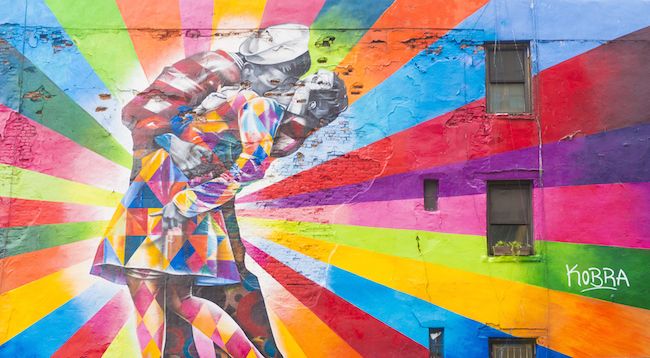Astronomical Sleuths Investigate Famous Times Square Kissers

An unlikely group of scientists, including physicists and astronomers, is helping solve one of history's most romantic mysteries: Who are the sailor and the woman in white seen kissing in the iconic "V-J Day in Times Square" photo?
Taken 70 years ago today, on Aug. 14, 1945, and published later in Life magazine, the photo is synonymous with the end of World War II and Victory over Japan Day, or V-J Day. That day is celebrated on Aug. 14 in the United Kingdom to commemorate the day that Japan announced its surrender. In the United States, V-J Day is celebrated on Sept. 2, the day Japan signed the official surrender documents.
On the first-ever V-J Day, lots of couples (and quite a few total strangers) kissed in celebration in New York City's Times Square. And while many people have come forward to say that they are the ones smooching in the famous "V-J Day in Times Square" photo, there really hasn't been a way to verify the identity of the pair in the photo — until now. [Image Gallery: WWII Lard, Relics Revealed by Storms]
Star-crossed smoochers
Using a historically accurate scale model of Times Square and knowledge of how the sun casts shadows on Earth, scientists from the University of Texas and Iowa State University calculated that the photo was taken at precisely 5:51 p.m. ET. This information, combined with first-person accounts from people who were in Times Square on that day, could help historians identify the smooching couple.
"Astronomy alone can't positively identify the participants, but we can tell you the precise moment of the photograph," Donald Olson, an astrophysicist at Texas State University, said in a statement.
To put an exact time to the photo, the scientists looked at the picture itself, which features an important clue: a clock. The Bond Clothes clock can be seen in the background, on the right, with the minute hand clearly pointing very near the 50-minute mark. However, the hour hand of the clock is obscured, so the researchers couldn't be sure at what hour the photo was taken.
Sign up for the Live Science daily newsletter now
Get the world’s most fascinating discoveries delivered straight to your inbox.
Luckily, the researchers found a different kind of clock in the picture, as well: a sundial. Every tall building in Manhattan acts like a sundial, its shadow moving in a predictable pattern as the sun travels across the sky. People have used sundials for millennia to accurately determine the time of day.
In the photograph, a building in Times Square casts a shadow on the Loew's Building, located behind the kissing couple.
By looking through historical photographs, the scientists determined that the shadow cast on the Loew's Building (formerly on the site of 701 7th Avenue) in "V-J Day in Times Square" was likely made by a large, inverted L-shape sign attached to the Hotel Astor. To test this hypothesis, the researchers built a scaled replica of Times Square exactly as it appeared in August 1945. Then, they used a mirror to project the sun's rays onto their model city. In this way, they discovered that the shadow on the Loew's Building could only have been cast by the Hotel Astor sign. And the sign would have cast that shadow at precisely 5:51 p.m.
Historical romance
This astronomical evidence has raised some doubt among the researchers about the commonly accepted story of the couple in "V-J Day in Times Square."
In 2012, the book "The Kissing Sailor" (Naval Institute Press, 2012) identified the people in the photo as George Mendonsa and Greta Zimmer. Mendonsa told the book's authors that he was watching a 1:05 p.m. film inside Radio City Music Hall when a theatre employee interrupted the movie to announce the news of Japan's surrender. Mendonsa said he ran outside, found his way to Times Square, and planted a kiss on a lady in white at around 2 p.m.
Zimmer, the "kissee," told the authors that she was on a late lunch break (from 1 to 2 p.m.) from her job at a dentist's office when she was swept up in the revelatory kiss. After returning to work, the dentist told her to cancel the rest of the appointments for the day in anticipation of the wild celebrations to follow.
Though these accounts are widely accepted in popular culture, neither matches up with the new time line established by Olson and his colleagues.
"The widely accepted scenario of 'The Kissing Sailor' book, with George Mendonsa kissing Greta Zimmer near 2 p.m., is ruled out by the astronomical analysis," Olson said. "Greta Zimmer's account states that she was on her late lunch hour, starting at 1 p.m., and after the kiss she returned to the office and the dentists told her to cancel the afternoon appointments. That's not going to happen after 6 p.m. Those details of her account are entirely inconsistent with the sunlight and shadows, which show that the photographed kiss happened at 5:51 p.m. If George Mendonsa is the kissing sailor, then he didn't go to the 1:05 p.m. movie — he went to Radio City for the 4:07 p.m. showing."
So if it isn't Mendonsa and Zimmer in the photo, then who is it? No one knows for sure, the researchers said.
"All those people have said they were there and identify themselves in the photograph," Olson said. "Who's telling the truth? They all could be telling the truth about kissing someone."
It seems there are some mysteries that even science can't solve.
Follow Elizabeth Palermo @techEpalermo. Follow Live Science @livescience, Facebook & Google+. Original article on Live Science.

Elizabeth is a former Live Science associate editor and current director of audience development at the Chamber of Commerce. She graduated with a bachelor of arts degree from George Washington University. Elizabeth has traveled throughout the Americas, studying political systems and indigenous cultures and teaching English to students of all ages.









